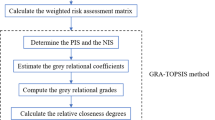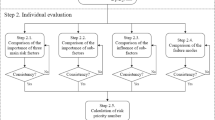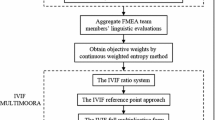Abstract
Failure mode and effects analysis (FMEA) is known to be a proactive reliability analysis model broadly utilized to recognize and evaluate potential failure modes in various industries. The normal risk priority number (RPN) method, however, has suffers from a lot of criticisms, such as requirement of precise risk estimation, lack of scientific basis in computing RPN, and neglecting the weights of risk factors. Therefore, this paper devises a new FMEA model to evaluate and prioritize the risk of failure modes by integrating probabilistic linguistic term sets and TODIM (an acronym in Portuguese for interactive multi-criteria decision making) method. The probabilistic linguistic term sets are utilized to handle the intrinsic ambiguity existed in the risk assessments of FMEA team members, whilst an extended TODIM method is employed for determining the priority ranking of the individuated failure modes. Further, based on the technique for order of preference by similarity to ideal solution (TOPSIS), an objective weighting method is presented to derive the relative weights of risk factors. Finally, two illustrative examples are implemented and comparisons with other existing methods are performed to demonstrate the rationality and superiority of our proposed FMEA model.



Similar content being viewed by others
References
Akyuz, E., & Celik, E. (2018). A quantitative risk analysis by using interval type-2 fuzzy FMEA approach: The case of oil spill. Maritime Policy and Management, 45(8), 979–994.
Al-Jarallah, R., & Aly, E.-E. A. A. (2014). Nonparametric tests for comparing several coefficients of variation. Communications in Statistics—Theory and Methods, 43(17), 3602–3613.
Baghery, M., Yousefi, S., & Rezaee, M. J. (2018). Risk measurement and prioritization of auto parts manufacturing processes based on process failure analysis, interval data envelopment analysis and grey relational analysis. Journal of Intelligent Manufacturing, 29(8), 1803–1825.
Bai, C., Kusi-Sarpong, S., Badri Ahmadi, H., & Sarkis, J. (2019). Social sustainable supplier evaluation and selection: A group decision-support approach. International Journal of Production Research, 57(22), 7046–7067.
Bowles, J. B., & Peláez, C. E. (1995). Fuzzy logic prioritization of failures in a system failure mode, effects and criticality analysis. Reliability Engineering and System Safety, 50(2), 203–213.
Braglia, M., Frosolini, M., & Montanari, R. (2003). Fuzzy TOPSIS approach for failure mode, effects and criticality analysis. Quality and Reliability Engineering International, 19(5), 425–443.
Can, G. F. (2018). An intutionistic approach based on failure mode and effect analysis for prioritizing corrective and preventive strategies. Human Factors and Ergonomics in Manufacturing and Service Industries, 28(3), 130–147.
Carpitella, S., Certa, A., Izquierdo, J., & La Fata, C. M. (2018). A combined multi-criteria approach to support FMECA analyses: A real-world case. Reliability Engineering and System Safety, 169, 394–402.
Chen, L., & Deng, Y. (2018). A new failure mode and effects analysis model using Dempster–Shafer evidence theory and grey relational projection method. Engineering Applications of Artificial Intelligence, 76, 13–20.
Chen, W., & Goh, M. (2019). Mechanism for cooperative partner selection: Dual-factor theory perspective. Computers and Industrial Engineering, 128, 254–263.
Dong, Y., Xu, Y., & Yu, S. (2009). Computing the numerical scale of the linguistic term set for the 2-tuple fuzzy linguistic representation model. IEEE Transactions on Fuzzy Systems, 17(6), 1366–1378.
Franceschini, F., & Galetto, M. (2001). A new approach for evaluation of risk priorities of failure modes in FMEA. International Journal of Production Research, 39(13), 2991–3002.
Gao, J., Xu, Z., Liang, Z., & Liao, H. (2019). Expected consistency-based emergency decision making with incomplete probabilistic linguistic preference relations. Knowledge-Based Systems, 176(15), 15–28.
Ghaleh, S., Omidvari, M., Nassiri, P., Momeni, M., & Lavasani, S. M. M. (2019). Pattern of safety risk assessment in road fleet transportation of hazardous materials (oil materials). Safety Science, 116, 1–12.
Gomes, L., & Lima, M. (1992). From modeling individual preferences to multicriteria ranking of discrete alternatives: A look at prospect theory and the additive difference model. Foundations of Computing and Decision Sciences, 17(3), 171–184.
Hu, Y.-P., You, X. Y., Wang, L., & Liu, H. C. (2018). An integrated approach for failure mode and effect analysis based on uncertain linguistic GRA–TOPSIS method. Soft Computing, 23(18), 8801–8814.
Huang, J., Li, Z., & Liu, H. C. (2017). New approach for failure mode and effect analysis using linguistic distribution assessments and TODIM method. Reliability Engineering and System Safety, 167, 302–309.
Kahneman, D., & Tversky, A. (1979). Prospect theory: An analysis of decision under risk. Econometrica, 47(2), 263–291.
Lê, L. S., & Wegmann, A. (2013). Hierarchy-oriented modeling of enterprise architecture using reference-model of open distributed processing. Computer Standards and Interfaces, 35(3), 277–293.
Lee, M., Pham, H., & Zhang, X. (1999). Methodology for priority setting with application to software development process. European Journal of Operational Research, 118(2), 375–389.
Li, M. Y., & Cao, P. P. (2018). Extended TODIM method for multi-attribute risk decision making problems in emergency response. Computers and Industrial Engineering, 135, 1286–1293.
Li, X., Li, H., Sun, B., & Wang, F. (2018). Assessing information security risk for an evolving smart city based on fuzzy and grey FMEA. Journal of Intelligent and Fuzzy Systems, 34(4), 2491–2501.
Liu, H. C. (2016). FMEA using uncertainty theories and MCDM methods. Singapore: Springer.
Liu, H. C., Hu, Y. P., Wang, J. J., & Sun, M. H. (2018). Failure mode and effects analysis using two-dimensional uncertain linguistic variables and alternative queuing method. IEEE Transactions on Reliability, 68(2), 554–565.
Liu, H. C., Liu, L., & Liu, N. (2013). Risk evaluation approaches in failure mode and effects analysis: A literature review. Expert Systems with Applications, 40(2), 828–838.
Liu, H. C., Wang, L. E., Li, Z., & Hu, Y. P. (2019a). Improving risk evaluation in FMEA with cloud model and hierarchical TOPSIS method. IEEE Transactions on Fuzzy Systems, 27(1), 84–95.
Liu, H. C., You, J. X., & Duan, C. Y. (2019b). An integrated approach for failure mode and effect analysis under interval-valued intuitionistic fuzzy environment. International Journal of Production Economics, 207, 163–172.
Liu, P., & Li, Y. (2019). Multi-attribute decision making method based on generalized maclaurin symmetric mean aggregation operators for probabilistic linguistic information. Computers and Industrial Engineering, 131, 282–294.
Liu, P., & Teng, F. (2019). Probabilistic linguistic TODIM method for selecting products through online product reviews. Information Sciences, 485, 441–455.
Lourenzutti, R., Krohling, R. A., & Reformat, M. Z. (2017). Choquet based TOPSIS and TODIM for dynamic and heterogeneous decision making with criteria interaction. Information Sciences, 408, 41–69.
Luo, S. Z., Zhang, H. Y., Wang, J. Q., & Li, L. (2019). Group decision-making approach for evaluating the sustainability of constructed wetlands with probabilistic linguistic preference relations. Journal of the Operational Research Society, 70(12), 2039–2055.
Ma, Z., Zhu, J., & Chen, Y. (2018). A probabilistic linguistic group decision-making method from a reliability perspective based on evidential reasoning. IEEE Transactions on Systems, Man, and Cybernetics: Systems. https://doi.org/10.1109/TSMC.2018.2815716.
Mangeli, M., Shahraki, A., & Saljooghi, F. H. (2019). Improvement of risk assessment in the FMEA using nonlinear model, revised fuzzy TOPSIS, and support vector machine. International Journal of Industrial Ergonomics, 69, 209–216.
Mao, X. B., Wu, M., Dong, J. Y., Wan, S. P., & Jin, Z. (2019). A new method for probabilistic linguistic multi-attribute group decision making: Application to the selection of financial technologies. Applied Soft Computing, 77, 155–175.
Michailidis, G., & de Leeuw, J. (1998). The gifi system of descriptive multivariate analysis. Statistical Science, 13(4), 307–336.
Michailidis, G., & De Leeuw, J. (2000). Multilevel homogeneity analysis with differential weighting. Computational Statistics and Data Analysis, 32(3–4), 411–442.
Michailidis, G., & De Leeuw, J. (2005). Homogeneity analysis using absolute deviations. Computational Statistics and Data Analysis, 48(3), 587–603.
Mohsen, O., & Fereshteh, N. (2017). An extended VIKOR method based on entropy measure for the failure modes risk assessment—A case study of the geothermal power plant (GPP). Safety Science, 92, 160–172.
Ozdemir, Y., & Gul, M. (2019). Measuring development levels of NUTS-2 regions in Turkey based on capabilities approach and multi-criteria decision-making. Computers and Industrial Engineering, 128, 150–169.
Panchal, D., Singh, A. K., Chatterjee, P., Zavadskas, E. K., & Keshavarz-Ghorabaee, M. (2019). A new fuzzy methodology-based structured framework for RAM and risk analysis. Applied Soft Computing, 74, 242–254.
Pancholi, N., & Bhatt, M. (2018). FMECA-based maintenance planning through COPRAS-G and PSI. Journal of Quality in Maintenance Engineering, 24(2), 224–243.
Pang, Q., Wang, H., & Xu, Z. (2016). Probabilistic linguistic term sets in multi-attribute group decision making. Information Sciences, 369, 128–143.
Rodríguez, R. M., Martínez, L., & Herrera, F. (2012). Hesitant fuzzy linguistic term sets for decision making. IEEE Transactions on Fuzzy Systems, 20(1), 109–119.
Safari, H., Faraji, Z., & Majidian, S. (2016). Identifying and evaluating enterprise architecture risks using FMEA and fuzzy VIKOR. Journal of Intelligent Manufacturing, 27(2), 475–486.
Sayyadi Tooranloo, H., & Ayatollah, A. S. (2016). A model for failure mode and effects analysis based on intuitionistic fuzzy approach. Applied Soft Computing, 49, 238–247.
Sharma, R. K., Kumar, D., & Kumar, P. (2005). Systematic failure mode effect analysis (FMEA) using fuzzy linguistic modelling. International Journal of Quality and Reliability Management, 22(9), 986–1004.
Simsekler, M. C. E., Kaya, G. K., Ward, J. R., & Clarkson, P. J. (2019). Evaluating inputs of failure modes and effects analysis in identifying patient safety risks. International Journal of Health Care Quality Assurance, 32(1), 191–207.
Song, W., Ming, X., Wu, Z., & Zhu, B. (2014). A rough TOPSIS approach for failure mode and effects analysis in uncertain environments. Quality and Reliability Engineering International, 30(4), 473–486.
Stamatis, D. H. (2003). Failure mode and effect analysis: FMEA from theory to execution (2nd ed.). New York: ASQ Quality Press.
Wang, L., Hu, Y. P., Liu, H. C., & Shi, H. (2019). A linguistic risk prioritization approach for failure mode and effects analysis: A case study of medical product development. Quality and Reliability Engineering International, 35(6), 1735–1752.
Wang, X., & Triantaphyllou, E. (2008). Ranking irregularities when evaluating alternatives by using some ELECTRE methods. Omega, 36(1), 45–63.
Wu, X., & Liao, H. (2018). An approach to quality function deployment based on probabilistic linguistic term sets and ORESTE method for multi-expert multi-criteria decision making. Information Fusion, 43(Supplement C), 13–26.
Xavier, M. A. S., Ferreira, F. A. F., & Esperança, J. P. (2018). An intuition-based evaluation framework for social credit applications. Annals of Operations Research. https://doi.org/10.1007/s10479-018-2995-8.
Xu, Z. S. (2004). A method based on linguistic aggregation operators for group decision making with linguistic preference relations. Information Sciences, 166(1–4), 19–30.
Yu, W., Zhang, H., & Li, B. (2019). Operators and comparisons of probabilistic linguistic term sets. International Journal of Intelligent Systems, 34(7), 1476–1504.
Zadeh, L. A. (1975). The concept of a linguistic variable and its application to approximate reasoning—I. Information Sciences, 8(3), 199–249.
Zhang, H., Dong, Y., Palomares-Carrascosa, I., & Zhou, H. (2018). Failure mode and effect analysis in a linguistic context: A consensus-based multiattribute group decision-making approach. IEEE Transactions on Reliability, 68(2), 566–582.
Zhang, L., Xin, H., Yong, H., & Kan, Z. (2019). Renewable energy project performance evaluation using a hybrid multi-criteria decision-making approach: Case study in Fujian, China. Journal of Cleaner Production, 206, 1123–1137.
Zheng, G., Jing, Y., Huang, H., & Gao, Y. (2010). Application of improved grey relational projection method to evaluate sustainable building envelope performance. Applied Energy, 87(2), 710–720.
Zhu, M., & Pham, H. (2018). A multi-release software reliability modeling for open source software incorporating dependent fault detection process. Annals of Operations Research, 269(1–2), 773–790.
Acknowledgements
The authors are very grateful to the respected editor and the anonymous referees for their insightful and constructive comments, which helped to improve the overall quality of the paper. This work was partially supported by the National Natural Science Foundation of China (Nos. 61773250, 71701153 and 71671125) and the Program for Shanghai Youth Top-Notch Talent.
Author information
Authors and Affiliations
Corresponding author
Additional information
Publisher's Note
Springer Nature remains neutral with regard to jurisdictional claims in published maps and institutional affiliations.
Rights and permissions
About this article
Cite this article
Huang, J., Liu, HC., Duan, CY. et al. An improved reliability model for FMEA using probabilistic linguistic term sets and TODIM method. Ann Oper Res 312, 235–258 (2022). https://doi.org/10.1007/s10479-019-03447-0
Published:
Issue Date:
DOI: https://doi.org/10.1007/s10479-019-03447-0




